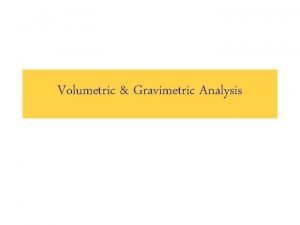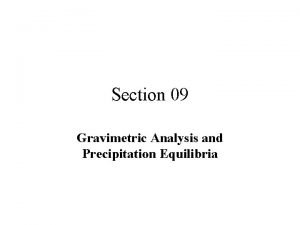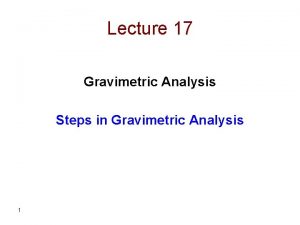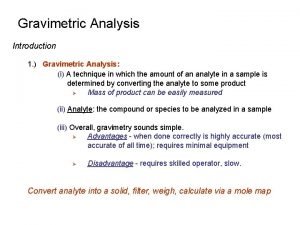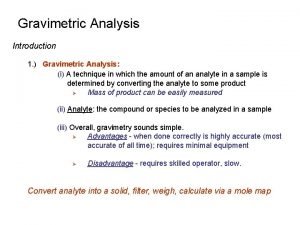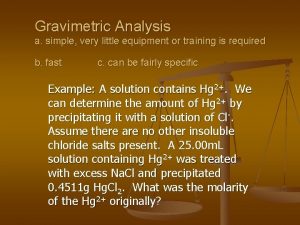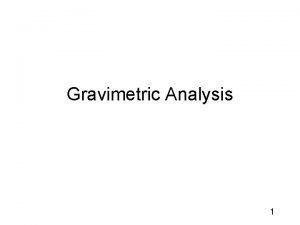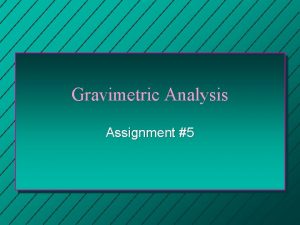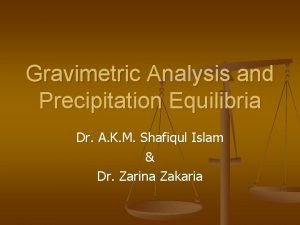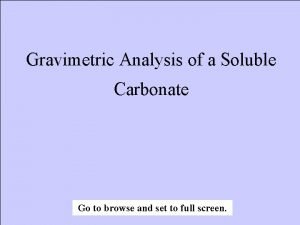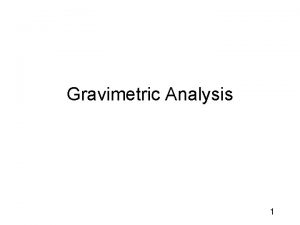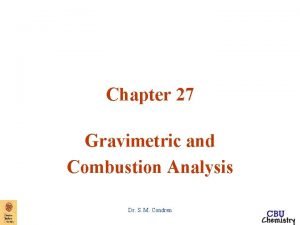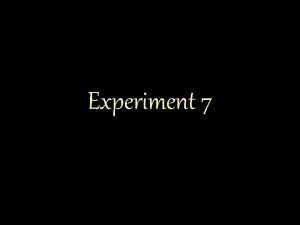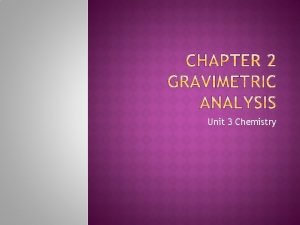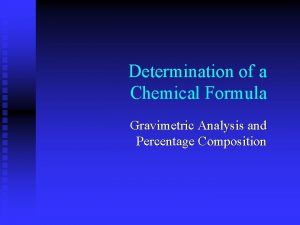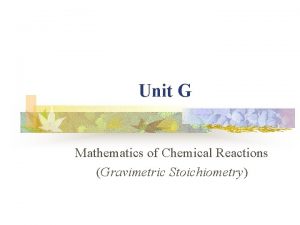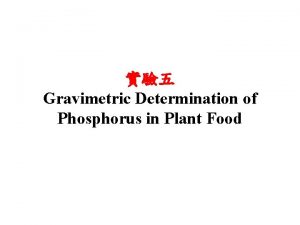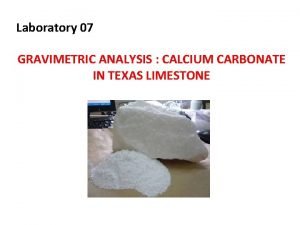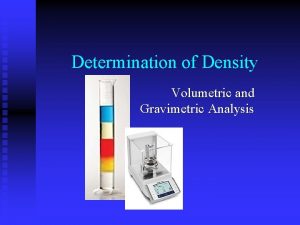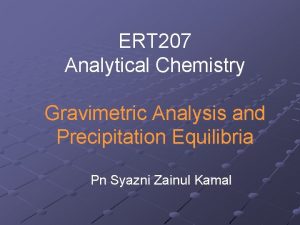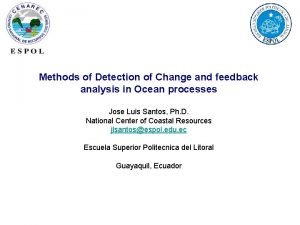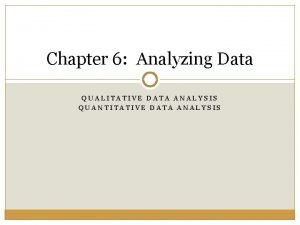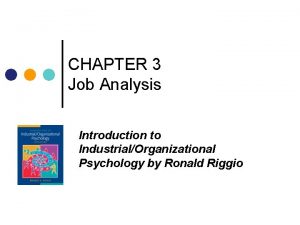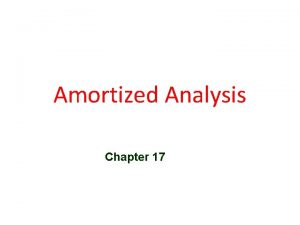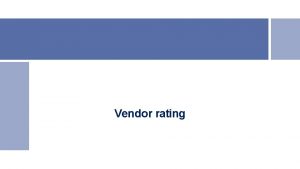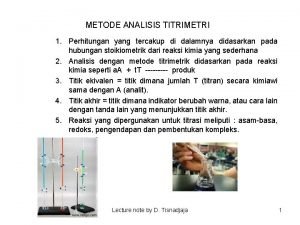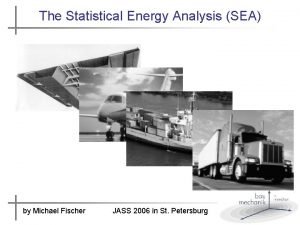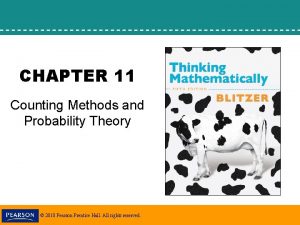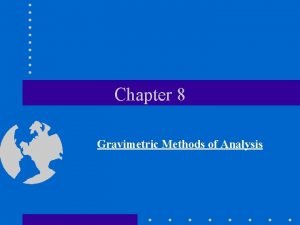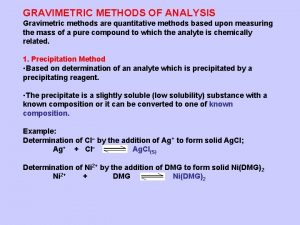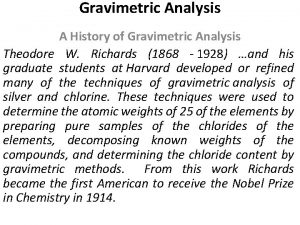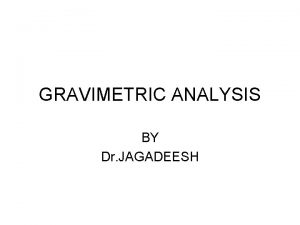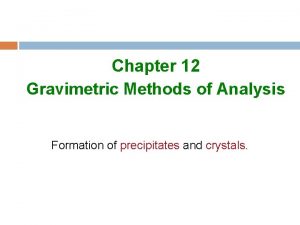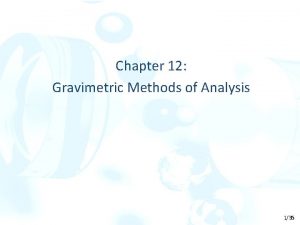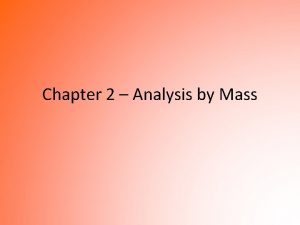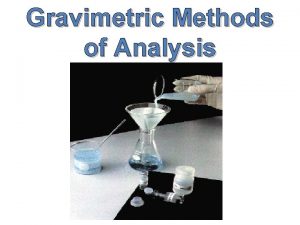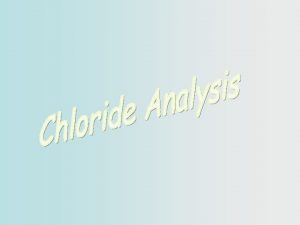Chapter 12 Gravimetric Methods of Analysis Gravimetric methods












































- Slides: 44

Chapter 12 Gravimetric Methods of Analysis

Gravimetric methods are quantitative methods that are based on determining the mass of a pure compound to which the analyte is chemically related. They are based on mass measurements with an analytical balance, an instrument that yields highly accurate and precise data. In precipitation gravimetry, the analyte is separated from a solution of the sample as a precipitate and is converted to a compound of known composition that can be weighed.

In volatilization gravimetry, the analyte is separated from other constituents of a sample by converting it to a gas of known chemical composition. The mass of the gas then serves as a measure of the analyte concentration. In electrogravimetry, the analyte is separated by deposition on an electrode by an electrical current. The mass of this product then provides a measure of the analyte concentration.

12 A Precipitation gravimetry The analyte is converted to a sparingly soluble precipitate that is then filtered, washed free of impurities and converted to a product of known composition by suitable heat treatment and weighed. Ex. , for determining the calcium content in water, an excess of oxalic acid is added to an aqueous solution of the sample. Ammonia is then added to neutralize the acid and the calcium in the sample precipitates as calcium oxalate. The precipitate is filtered, dried and ignited, which converts it to calcium oxide. After cooling, the precipitate is weighed and the mass is determined.

Properties of Precipitates and Precipitating Reagents Specific reagents react only with a single chemical species. Selective reagents, which are more common, react with a limited number of species. A gravimetric precipitating agent should react specifically or at least selectively with the analyte and give a product that is: 1. easily filtered and washed free of contaminants; 2. of sufficiently low solubility that no significant loss of the analyte occurs during filtration and washing; 3. unreactive with constituents of the atmosphere; 4. of known chemical composition after it is dried or, if necessary, ignited.

Particle Size and Filterability of Precipitates consisting of large particles are generally desirable for gravimetric work because these particles are usually purer than fine particles, easy to filter, and easy to wash free of impurities. Factors That Determine the Particle Size of Precipitates ØThe particle size may vary greatly from colloidal suspensions to crystalline suspensions. ØA colloid consists of solid particles from 10 -7 to 10 -4 cm in diameter that are invisible to the naked eye.

ØColloidal particles show no tendency to settle from solution and are difficult to filter. They can be made to coagulate to produce large particles that are easy to filter. ØIn diffuse light, colloidal suspensions may be perfectly clear and appear to contain no solid. ØBecause particles of colloidal dimensions scatter visible radiation, the path of the beam through the solution can be seen by the eye. This phenomenon is called the Tyndall effect.

The temporary dispersion of particles with dimensions on the order of tenths of a millimeter or greater in the liquid phase is called a crystalline suspension. The particles of a crystalline suspension tend to settle spontaneously and are easily filtered. The particle size of a precipitate is influenced by precipitate solubility, temperature, reactant concentrations, and the rate at which reactants are mixed.

The net effect of these variables can be accounted for by assuming that the particle size is related to a single property of the system called relative supersaturation (Q – S)/S where Q is the concentration of the solute at any instant, S is its equilibrium solubility. A supersaturated solution is an unstable solution that contains a higher solute concentration than a saturated solution. As excess solute precipitates with time, supersaturation decreases to zero.

Mechanism of Precipitate Formation We can assume that precipitates form in two ways: nucleation and particle growth. Nucleation is a process in which a minimum number of atoms, ions, or molecules join together to give a stable solid. These nuclei form on the surface of suspended solid contaminants. If nucleation predominates, a large number of very fine particles is produced. If particle growth predominates, a smaller number of larger particles is obtained.

The rate of nucleation is believed to increase enormously with increasing relative supersaturation. When a precipitate is formed at high relative supersaturation, nucleation is the major precipitation mechanism. At low relative supersaturations, the rate of particle growth tends to predominate, and deposition of solid on existing particles occurs.

Experimental Control of Particle Size Elevated temperatures to increase the solubility of the precipitate, dilute solutions to minimize Q, and slow addition of the precipitating agent with good stirring help produce crystalline precipitates. If the solubility of the precipitate depends on p. H, larger particles can also be produced by controlling p. H. Precipitates that have very low solubilities, such as many sulfides and hydrous oxides, generally form as colloids.

Colloidal Precipitates Individual colloidal particles are too small to be retained by ordinary filters and Brownian motion prevents their settling out of solution. These have to be coagulated to give a filterable, amorphous mass that will settle out of solution. Coagulation of Colloids Coagulation can be hastened by heating, by stirring, and by adding an electrolyte to the medium. Colloidal suspensions are stable because all of the particles of the colloid are either positively or negatively charged and thus repel one another.

Adsorption is a process in which a substance (gas, liquid, or solid) is held on the surface of a solid. In contrast, absorption is retention of a substance within the pores of a solid. The adsorption of ions on an ionic solid originates from the normal bonding forces that are responsible for crystal growth. The charge on a colloidal particle formed in a gravimetric analysis is determined by the charge of the lattice ion that is in excess when the precipitation is complete.

Figure 12 -1 A colloidal silver chloride particle suspended in a solution of silver nitrate. Attached directly to the solid surface is the primary adsorption layer. Surrounding the charged particle is a layer of solution, called the counter-ion layer.

Figure 12 -2 a shows the effective charge on two silver chloride particles. The upper curve represents a particle in a solution that contains a reasonably large excess of silver nitrate, and the lower curve depicts a particle in a solution that has a much lower silver nitrate content.

Figure 12 -3 The electrical double layer of a colloid The effective charge falls off rapidly as the distance from the surface increases, and it approaches zero at the points d 1 or d 2. Increasing the electrolyte concentration has the effect of decreasing the volume of the counter-ion layer, thereby increasing the chances for coagulation.

Peptization of Colloids Peptization is the process by which a coagulated colloid reverts to its original dispersed state. When a coagulated colloid is washed, some of the electrolyte responsible for its coagulation is leached from the internal liquid in contact with the solid particles. Removal of this electrolyte has the effect of increasing the volume of the counter-ion layer. The repulsive forces responsible for the original colloidal state are then reestablished, and particles detach themselves from the coagulated mass.

Practical Treatment of Colloidal Precipitates Colloids are best precipitated from hot, stirred solutions containing sufficient electrolyte to ensure coagulation. Digestion is a process in which a precipitate is heated in the solution from which it was formed (the mother liquor) and allowed to stand in contact with the solution. Mother liquor is the solution from which a precipitate was formed.

Crystalline Precipitates Crystalline precipitates are generally more easily filtered and purified than are coagulated colloids. Particle size of crystalline solids can often be improved significantly by minimizing Q (by using dilute solutions) or maximizing S (precipitating from hot solution or by adjusting the p. H), or both. Digestion improves the purity and filterability of both colloidal and crystalline precipitates. Coprecipitation is a process in which normally soluble compounds are carried out of solution by a precipitate. There are four types: surface adsorption, mixed-crystal formation, occlusion, and mechanical entrapment.

Surface Adsorption is a common source of coprecipitation and is likely to cause significant contamination in coagulated colloids but of no significance in crystalline precipitates. In adsorption, a normally soluble compound is carried out of solution on the surface of a coagulated colloid. This compound consists of the primarily adsorbed ion and an ion of opposite charge from the counter-ion layer. The net effect of surface adsorption is, therefore, the carrying down of an otherwise soluble compound as a surface contaminant.

Figure 12 -4 A coagulated colloid

Minimizing adsorbed impurities on Colloids The purity of many coagulated colloids is improved by digestion. Washing a coagulated colloid with a solution containing a volatile electrolyte may also be helpful because any nonvolatile electrolyte added earlier to cause coagulation is displaced by the volatile species. Regardless, a coagulated colloid is always contaminated to some degree, even after extensive washing. The error introduced into the analysis from this source can be as low as 1 to 2 ppt.

Reprecipitation The filtered solid is redissolved and reprecipitated. The first precipitate usually carries down only a fraction of the contaminant. The solution containing the redissolved precipitate has a significantly lower contaminant concentration than the original, and even less adsorption occurs during the second precipitation.

Mixed-Crystal Formation It is a type of coprecipitation in which a contaminant ion replaces an ion in the lattice of a crystal. It is necessary that the two ions have the same charge and that their sizes differ by no more than about 5%, and must belong to the same crystal class. The extent of mixed-crystal contamination is governed by the law of mass action and increases as the ratio of contaminant to analyte concentration increases.

Occlusion and Mechanical Entrapment Occlusion is a type of coprecipitation in which a compound is trapped within a pocket formed during rapid crystal growth. Supersaturation and growth rate decrease as precipitation progresses, hence the amount of occluded material is greatest in that part of a crystal that forms first. Mechanical entrapment occurs when crystals lie close together during growth, entrapping a portion of the solution. In case of low supersaturation or digestion, the effects of these coprecipitations are reduced.

Coprecipitated impurities may cause either negative or positive errors. If the contaminant is not a compound of the ion being determined, a positive error will always result. In contrast, when the contaminant does contain the ion being determined, either positive or negative errors may occur. Precipitation from Homogeneous Solution Homogeneous precipitation is a process in which a precipitate is formed by slow generation of a precipitating reagent homogeneously throughout a solution. Solids formed by homogeneous precipitation are generally purer and more easily filtered than precipitates generated by direct addition of a reagent to the analyte solution.

Figure 12 -5 Aluminum hydroxide formed by the direct addition of ammonia (left) and the homogeneous production of hydroxide (right). Urea is often used for the homogeneous generation of hydroxide ion. Adjoining figure shows hydrous oxide precipitates of aluminum formed by direct addition of base and by homogeneous precipitation with urea.


Drying and Ignition of Precipitates A gravimetric precipitatate is heated until its mass becomes constant. This new compound is called the weighing form. Graphs show mass loss as a function of temperature for three analytical precipitates —silver chloride, barium sulfate, and aluminum oxide. The temperature required to dehydrate a precipitate completely may be as low as 100°C or as high as 1000°C. Recording thermal decomposition curves is called thermogravimetric analysis, and the mass versus temperature curves are termed thermograms.

Figure 12 -6 Effect of temperature on precipitate mass.

Figure 12 -7 Schematic of a thermobalance: A: beam; B: sample cup and holder; C: counterweight; D: lamp and photodiodes; E: coil; F: magnet; G: control amplifier; H: tare calculator; I: amplifier; and J: recorder.

12 B Calculation of results from gravimetric data





12 C Applications of gravimetric methods Gravimetric methods do not require a calibration or standardization step because the results are calculated directly from the experimental data and atomic masses. Thus, when only one or two samples are to be analyzed, a gravimetric procedure may be the method of choice because it requires less time and effort than a procedure that requires preparation of standards and calibration.

Inorganic Precipitating Agents

Reducing Agents Organic Precipitating Agents There are two types of organic reagents: one forms slightly soluble nonionic products called coordination compounds, and the other forms products in which the bonding between the inorganic species and the reagent is largely ionic.

Organic reagents that yield sparingly soluble coordination compounds typically contain at least two functional groups. Each of these groups is capable of bonding with a cation by donating a pair of electrons. The functional groups are located in the molecule such that a five- or six-membered ring results from the reaction. Reagents that form compounds of this type are called chelating agents, and their products are called chelates. Metal chelates are relatively nonpolar and have solubilities that are low in water but high in organic liquids.

Organic Functional Group Analysis

Volatilization Gravimetry The two most common gravimetric methods based on volatilization are those for determining water and carbon dioxide. In direct determination, water vapor is collected on any of several solid desiccants, and its mass is determined from the mass gain of the desiccant. In the indirect method, the amount of water is determined by the loss of mass of the sample during heating.

Figure 12 -8 Apparatus for determining the sodium hydrogen carbonate content of antacid tablets by a gravimetric volatilization procedure.
 Difference between colloidal and crystalline precipitate
Difference between colloidal and crystalline precipitate Difference between gravimetric and volumetric analysis
Difference between gravimetric and volumetric analysis Factors affecting tg curve
Factors affecting tg curve Gravimetric factor calculation
Gravimetric factor calculation Steps in gravimetric analysis
Steps in gravimetric analysis Types of gravimetric analysis
Types of gravimetric analysis Introduction to gravimetric analysis
Introduction to gravimetric analysis Gravimetric analysis
Gravimetric analysis Inclusion in gravimetric analysis
Inclusion in gravimetric analysis Apa itu metode gravimetri
Apa itu metode gravimetri Classification of gravimetric analysis
Classification of gravimetric analysis Gravimetry steps
Gravimetry steps Occlusion and mixed-crystal formation
Occlusion and mixed-crystal formation Define gravimetric factor
Define gravimetric factor Von weimarn ratio
Von weimarn ratio What makes water hard
What makes water hard Desicooler
Desicooler Inclusion in gravimetric analysis
Inclusion in gravimetric analysis Gravimetric combustion analysis
Gravimetric combustion analysis Gravimetric principle
Gravimetric principle Gravimetric method
Gravimetric method Gravimetric analysis formula
Gravimetric analysis formula Wax pattern in dentistry
Wax pattern in dentistry Gravimetric stoichiometry
Gravimetric stoichiometry Gravimetric determination of phosphorus in plant food
Gravimetric determination of phosphorus in plant food Gravimetric determination of calcium lab report
Gravimetric determination of calcium lab report Gravimetric determination of chloride lab report conclusion
Gravimetric determination of chloride lab report conclusion Von weimarn ratio
Von weimarn ratio Fact finding techniques in system analysis and design
Fact finding techniques in system analysis and design Energy method
Energy method Feedback analysis methods
Feedback analysis methods Methods of data collection in legal research
Methods of data collection in legal research Data analysis methods
Data analysis methods Methods of job analysis in industrial psychology
Methods of job analysis in industrial psychology Method
Method Aggregate analysis in daa
Aggregate analysis in daa Input design and output design
Input design and output design Methods of vendor rating
Methods of vendor rating Titrimetri
Titrimetri How to analyze characterization
How to analyze characterization Huff's law of shopper attraction
Huff's law of shopper attraction Methods of vibration analysis
Methods of vibration analysis Research methods design and analysis
Research methods design and analysis Chapter 19 methods of therapy
Chapter 19 methods of therapy Chapter 11 counting methods and probability theory answers
Chapter 11 counting methods and probability theory answers

